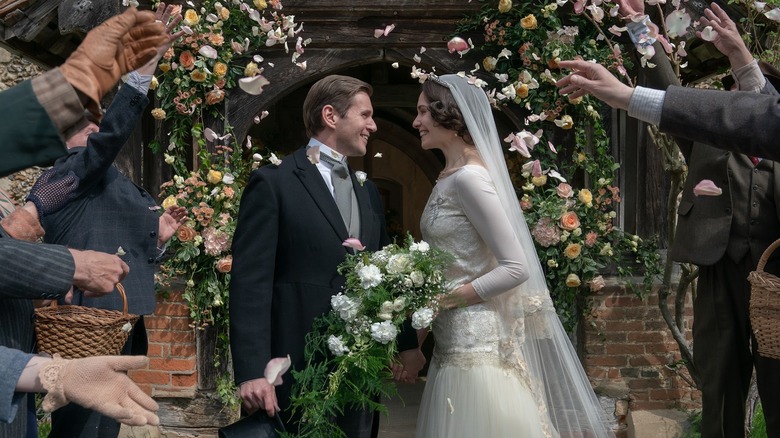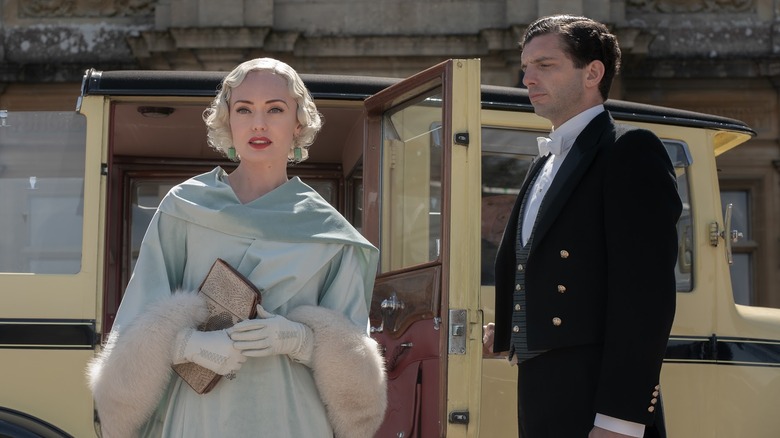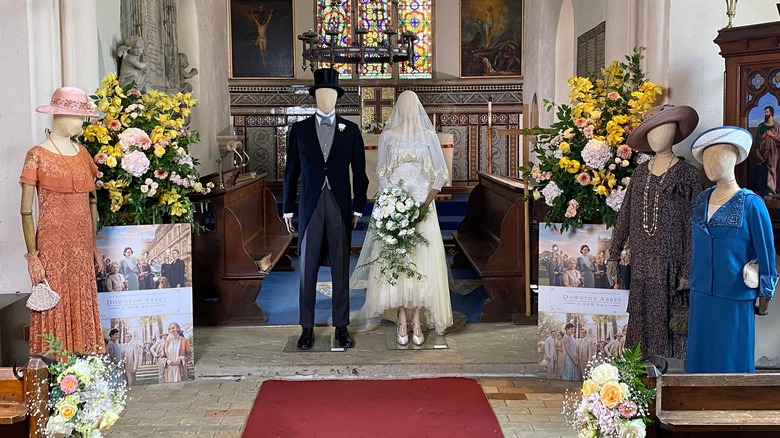Downton Abbey: A New Era Costume Designer Anna Robbins On Bringing The Allure Of Hollywood Glamor To Downton [Interview]
Costume dramas' wardrobe departments allow a peek into a bygone era in which the fashion of the past is made anew, and in "Downton Abbey: A New Era," we get to see the clash of colors, fabrics, and radical clothing as the '30s are just around the corner. Given its place in the early 20th century, "Downton Abbey" allows for the Crawleys to have more of an opportunity to delve into the different fashions through the decades it takes place, while the downstairs staff is often regulated to their uniforms. But in this sequel, Hollywood has come to Downton, which provides nearly everyone with an opportunity to break out of their uniformal clothing constraints and try something new.
With "Downton Abbey: A New Era" now available on Digital, and arriving soon to 4K, Blu-ray, and DVD (July 5), I got to speak with the film's costume designer, Anna Robbins, whose splendid work has been showcased with "Downton Abbey" since the series' fifth season, about the influences of the film within a film, in addition to how it contrasts with the evolving fashion of the aristocratic Crawleys. It was made an even more memorable experience in that our conversation took place within The Church of St. Mary, the same 14th century location where Tom (Allen Leech) and Lucy (Tuppence Middleton) get married at the top of the film.
'I think our idea very early on was that her palette should be really different to the palette of the women of Downton Abbey'
So one thing I really love, one of my favorite scenes in the film, is when the downstairs crew comes up for Mr. Barber's film, and I wanted to ask, did anyone have any special requests for their costumes?
I mean, lots of requests. It was like the kind of big opportunity to dress, how we always imagined it, and it was just so lovely for it to actually come true. I think the first request, it was an unsaid request because Lesley Nicol's been dreaming for years about wearing a tiara. So that was one of the first things I think we sourced for that scene, is that we knew that this was the opportunity that we'd able to pop some diamonds onto Mrs. Patmore. And so, yeah. There was that, I mean, there was the sense of Baxter's costume being as romantic as possible because we knew that there was going to be the proposal and ... it was I think about just finding each character in a completely different way and being able to really showcase them.
I was really struck by Mrs. Hughes, considering we always see her in usually like a black or a dark blue, and she comes down in kind of like this midnight blue outfit that really accentuates her for the film.
Yeah. I mean, and she's still covered up as well, Mrs. Hughes. You don't see much of her. She's always really proper. So the fact that you're seeing skin and it's like these really beautiful necklines and full skirts and she just looked beautiful because there's such a contrast to the Mrs. Hughes that we see day in, day out in one or two costumes first.
Exactly. I think when Myrna has her big movie star entrance, she has an amazing blue coat with the fur that's only there for that one moment, but it's such a powerful moment. How did you come about making everything for that one? It's only in that one scene, but how did you decide on that costume in particular?
It felt like one of the most important costumes for Myrna, and I think our idea very early on was that her palette should be really different to the palette of the women of Downton Abbey. And it was about looking at these icy tones that kind of reflected her slightly standoffish personality, complimenting this platinum blonde that Nosh [Anne Oldham] designed for her wigs and looking at the Hollywood glamor and the kind of the Hollywood actors of that time and drawing inspiration from how glamorous they were.
It's like a very different idea of beauty to the classic beauty of the ladies of the Abbey, so I think that was what we wanted to get was this amazing contrast. And we found these incredible original shoes. And then knowing that we got that lovely pan out shot, where we get to feature them was amazing because often you don't get to see the shoes. And so that was great. I had a great co-designer on the film, Maja [Meschede]. And Maja led on this costume, and so it was her idea to have this really icy blue and the shape of the cape to give this really dramatic silhouette as she stalks into the abbey. And yeah, it's like costume perfection. Yeah.
'It was about finding this lovely mashup of 19th century silhouettes with '20s materials, '20s jewelry, '20s styling'
I was really curious about your influences from the silent era to early talkies. Did you have any [films] in particular that you used to kind of mold the cast of Mr. Barber's film?
There were lots of different factors. So we had the crew coming in, and so we had loads of amazing images of film crews from that time. And it was really picking apart and seeing that there was a real sense of separates being worn, which felt really contemporary compared to the three-piece suiting of the aristocratic classes. So there was like a kind of a relaxed, arty vibe to it, looking at the kind of Bloomsbury lot and just trying to get a sense of it feeling like a very different world that was coming in. So there was the crew, but then there was the cast where there was the kind of glamor of Hollywood and looking at the greats from that era, like Clark Gable and Marlene Dietrich and Greta Garbo and Myrna Loy and Louise Brooks. So great people that we could tap into there.
And then there was the other layer, which was the fact we were able to explore the 1870s through a 1920s lens. So we were able to look at films that had been made in the '40s that were set a century before the '60s, even, and looking at what it was that still said, "This is 1964" or whatever. And it was this sort of funny mix of period with what would've been contemporary at the time. So it was about finding this lovely mashup of 19th century silhouettes with '20s materials, '20s jewelry, '20s styling. And so there was just so many layers to the film within the film that, yeah, it was great fun to costume.
And as Downton heads into the '30s, I've noticed a lot more casual wear in "A New Era." Who do you feel had the most radical costumes for the period?
In terms of radical costumes, I would say that Lady Edith takes a massive sartorial jump forward into trousers. The pajama set on the Riviera at that time was all the rage and was, again, some great visual references there. So it felt like the right moment that she would've taken that step. It felt fitting and that she would've been the person to embrace that look. I mean, we have Lucy and Branson in swimwear. That was really fun to do. The tennis wear, as well, was great. That was a really kind of lovely ensemble piece to be able to look at that. I don't know, the list goes on.
It just keeps going. There was one more thing I wanted to ask. You mentioned Phyllis's dress when she has the big proposal scene. And I thought it was great how her floral arrangements with the flowers on top kind of mirrored Myrna in her final scene. Was that an intentional thing to like mirror the proposal that kind of overshadows the actor?
Yeah. I mean, it was always going to be like such a special moment. Molesley makes me cry. Just seeing him, Kevin [Doyle], on camera is just a joy to behold. So I knew that scene was going to be really emotional and it needed to feel really romantic. And so there's these vintage silk flowers on her dress that are part of my personal collection because I collect them when I see them and we just wanted it to feel really special. So if it resonates with Myrna's A-list Hollywood, glamorous looks, then wonderful.
"Downton Abbey: A New Era" is on Digital now and hits 4K/Blu-ray/DVD on July 5, 2022.


